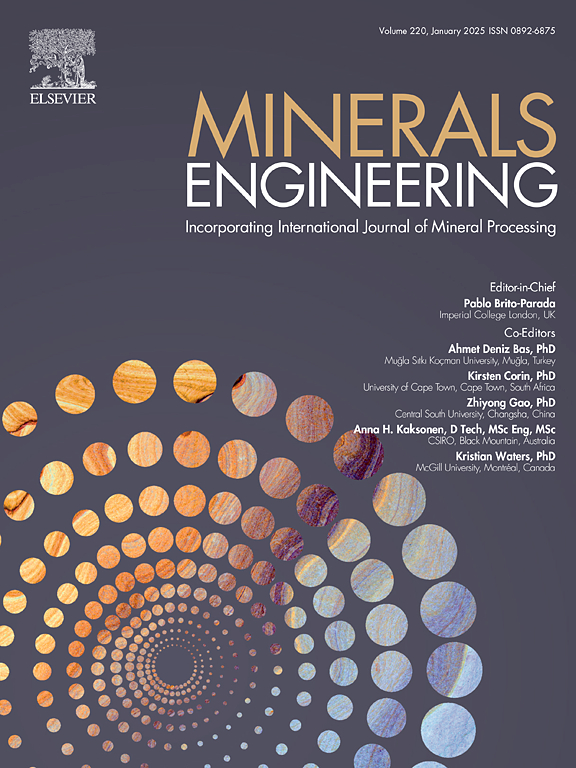塔拉胶对磷灰石与方解石浮选分离的抑制机理:实验与分子动力学模拟
IF 4.9
2区 工程技术
Q1 ENGINEERING, CHEMICAL
引用次数: 0
摘要
为了解决通过浮选选择性区分磷灰石和方解石的挑战,在本研究中,塔拉胶(TG)发挥了方解石选择性抑制剂的作用。微浮选试验表明,以油酸钠(NaOL)为捕收剂时,磷灰石和方解石的浮力特性相当。仅仅依靠NaOL就很难实现这两种矿物的有效分离。TG的加入对方解石的可浮性有明显的选择性抑制作用,而对磷灰石的浮选无明显影响。人工混合矿试验结果表明,TG的抑制作用不仅提高了磷灰石中P2O5的品位,而且对磷灰石的回收率影响较小。表面润湿性测试表明,在TG和NaOL的共同作用下,磷灰石和方解石的疏水性差异进一步扩大。Zeta电位测量结果表明,体系中TG的存在并不影响NaOL在磷灰石表面的吸附,但严重阻碍了NaOL在方解石表面的吸附。吸附量实验结果表明,TG在方解石表面的吸附量明显高于在磷灰石表面的吸附量。x射线光电子能谱(XPS)测量分析证实,TG通过弱相互作用吸附在磷灰石表面,而在方解石表面,它通过羟基与Ca进行了强烈的化学吸附。模拟计算的结果进一步证实,相对于磷灰石,TG在方解石表面具有更大的附着倾向。基于这些实验发现,TG有望成为磷灰石和方解石浮选分离的歧视性抑制剂。本文章由计算机程序翻译,如有差异,请以英文原文为准。
The depression mechanism of tara gum on the flotation separation of apatite from calcite: Experiments and molecular dynamics simulation
To address the challenges in selectively differentiating apatite from calcite via flotation, Tara gum (TG) functioned in the role of a calcite-selective inhibitor during this research. The micro-flotation tests indicated that apatite and calcite displayed comparable buoyancy characteristics when sodium oleate (NaOL) was utilized as the collector. Merely relying on NaOL alone made it extremely arduous to effectuate an efficient segregation of these two minerals. The addition of TG manifested potent and selective inhibitory effect on calcite floatability, while exerted no substantial influence on the flotation of apatite. The findings from the artificial mixed ore tests signified that employing TG in a suppressing role not only enhanced the P2O5 grade within apatite but also had a relatively minor effect on the recovery rate. Surface wettability tests demonstrated that under the combined influence of TG and NaOL, the disparity in hydrophobicity between apatite and calcite was further augmented. Zeta potential measurements intimated TG being present in the system did not impinge on the adsorption of NaOL on the surface of apatite but severely impeded its adsorption on the surface of calcite. Experimental findings from adsorption capacity tests revealed the adsorption quantity of TG on the surface of calcite exhibited a significantly elevated magnitude compared to that on the surface of apatite. X-ray photoelectron spectroscopy (XPS) measurements analysis corroborated that TG was adsorbed on the surface of apatite via weak interactions, while atop the calcite surface, it underwent robust chemisorption with Ca through hydroxyl groups. The outcomes of simulation calculations further substantiated that TG had a greater propensity to attach across the surface of calcite relative to apatite. Based on these experimental revelations, TG held the promise of serving functioning as a discriminatory suppressing agent for the flotation separation of apatite from calcite.
求助全文
通过发布文献求助,成功后即可免费获取论文全文。
去求助
来源期刊

Minerals Engineering
工程技术-工程:化工
CiteScore
8.70
自引率
18.80%
发文量
519
审稿时长
81 days
期刊介绍:
The purpose of the journal is to provide for the rapid publication of topical papers featuring the latest developments in the allied fields of mineral processing and extractive metallurgy. Its wide ranging coverage of research and practical (operating) topics includes physical separation methods, such as comminution, flotation concentration and dewatering, chemical methods such as bio-, hydro-, and electro-metallurgy, analytical techniques, process control, simulation and instrumentation, and mineralogical aspects of processing. Environmental issues, particularly those pertaining to sustainable development, will also be strongly covered.
 求助内容:
求助内容: 应助结果提醒方式:
应助结果提醒方式:


